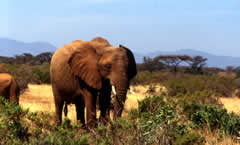 THOMPSON SAYS FOOD SUPPLY VULNERABLE TO ATTACK
THOMPSON SAYS FOOD SUPPLY VULNERABLE TO ATTACK
The number of U.S. food inspectors has risen over the last year, but Health and Human Services Secretary Tommy Thompson said the nation is still vulnerable to an attack on its food supply. It was clear even before Sept. 11 that the Food and Drug Administration’s inspection system had big holes, the Associated Press reports, with 150 inspectors together examining less than one percent of the nation’s food. After last fall, Congress opened the purse strings enough to hire 750 additional inspectors, and new technology has made some inspections faster. But Thompson said danger remains. “I still believe that is the area we are subject to a terrorist attack in the future and one that could cause problems.” In perhaps the most shocking part of Thompson’s coments, he blamed the previously low number of inspectors on a vindictive Congress that punished the agency for former FDA Commissioner David Kessler’s efforts to regulate the tobacco industry.
Meanwhile…
DUST-SIZED CHIPS TO COMBAT BIOTERRORISM
Silicon chips the size of dust particles that can quickly detect biological and chemical agents have been developed by University of California, San Diego scientists. As reported by HealthScoutNews, the versatile chips can identify substances that can be dissolved in drinking water or sprayed into the air during a bioterrorist attack. “The idea is that you can have something that’s as small as a piece of dust with some intelligence built into it, so that it could be inconspicuously stuck to paint on a wall or to the side of a truck or dispersed into a cloud of gas,” UCSD researcher Michael Sailor said. Each chip is barcoded, and can be read using a laser detector to see what if any reaction has occurred. “When the dust recognizes what kinds of chemicals or biological agents are present, that information can be read … to tell us if the cloud that’s coming toward us is filled with anthrax bacteria or if the tank of drinking water into which we’ve sprinkled the dust is toxic,” Sailor said.
 You learn a lot analyzing dung. Sampling specimens from wild African elephants, UC San Diego researchers have found the continent is home to three distinct types of Proboscidia, not two. Apparently the distinction in the past was between savanna and forest elephants. Now it turns out a third, genetically distinct species has evolved that swings both ways.
You learn a lot analyzing dung. Sampling specimens from wild African elephants, UC San Diego researchers have found the continent is home to three distinct types of Proboscidia, not two. Apparently the distinction in the past was between savanna and forest elephants. Now it turns out a third, genetically distinct species has evolved that swings both ways.
 THOMPSON SAYS FOOD SUPPLY VULNERABLE TO ATTACK
THOMPSON SAYS FOOD SUPPLY VULNERABLE TO ATTACK